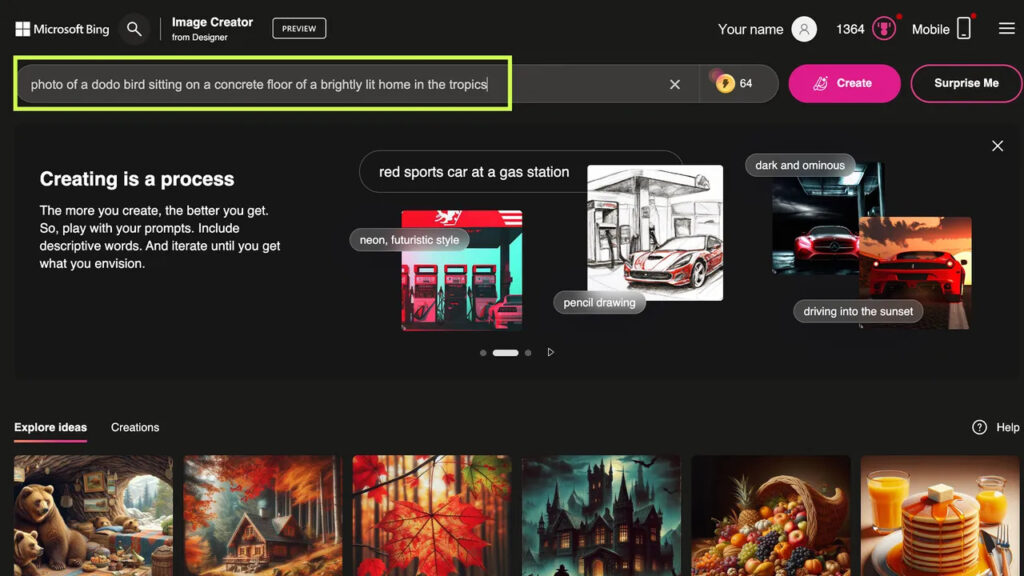In the current technological landscape, artificial intelligence (AI) has become an omnipresent force, influencing and shaping various facets of our daily lives. Within this vast realm, the convergence of AI and visual recognition stands out as a groundbreaking development, with Bing Image AI emerging as a trailblazer in this transformative journey. This blog will delve into the intricate details of Bing Image AI, its profound impact on visual recognition, and the promising future it holds.

Introduction
The ubiquity of artificial intelligence is palpable, infiltrating our routines and interactions with technology. AI’s influence has reached a point where it not only complements but significantly enhances our experiences. A prime example of this symbiotic relationship between humans and machines is evident in the fusion of AI with visual recognition technologies, and at the forefront of this union is Bing Image AI.
This blog aims to unravel the multifaceted dimensions of Bing Image AI and explore how it is revolutionizing visual recognition, ultimately paving the way for a future where the potency of visual intelligence takes center stage.
Understanding Image AI
To comprehend the revolution that Bing Image AI is spearheading, it is imperative to delve into the underpinnings of image AI. At its core, Bing Image AI relies on the dynamic interplay of machine learning and deep learning, propelling the system into realms of understanding and interpretation previously deemed unattainable.
Machine learning, a subset of AI, equips Bing Image AI with the ability to learn from vast datasets, refining its accuracy in recognizing and analyzing images. This iterative learning process enables the system to adapt and evolve, enhancing its capabilities over time. Deep learning, on the other hand, amplifies these capabilities by employing neural networks to simulate human-like decision-making processes, making Bing Image AI adept at deciphering complex patterns within visual data.
In essence, the amalgamation of machine learning and deep learning empowers Bing Image AI to achieve a nuanced understanding of visual information, ushering in a new era of automated recognition.
The Power of Visual Intelligence
Visual intelligence, a central theme in the realm of Bing Image AI, extends beyond the conventional boundaries of image processing. It encapsulates the system’s capacity not only to perceive images but to comprehend and derive meaning from them. This elevates Bing Image AI from a mere image recognition tool to a platform that genuinely understands the intricacies of the visual world.
The importance of visual intelligence becomes apparent when considering its applications across various domains. In healthcare, Bing Image AI contributes to early disease detection through the analysis of medical images, showcasing its potential to revolutionize diagnostics. In manufacturing, it optimizes quality control processes by identifying defects with precision, enhancing operational efficiency. The incorporation of visual intelligence in these diverse domains underscores its transformative impact and sets the stage for a more sophisticated human-machine visual collaboration.
Next-Generation Visual Technology
The evolution of image processing and classification is accelerating with the integration of AI, and Bing Image AI is positioned at the vanguard of this transformative wave. Cutting-edge algorithms form the backbone of its visual technology, endowing the system with the ability to recognize objects and scenes with unprecedented accuracy.
These algorithms, akin to digital sentinels, meticulously decipher intricate details within images. Whether it’s identifying objects in cluttered scenes or discerning subtle nuances, Bing Image AI’s next-generation visual technology represents a paradigm shift in automated image recognition. The integration of innovative image analysis techniques further propels this evolution, enabling Bing Image AI to not only identify static elements but also comprehend dynamic aspects, such as movements and changes over time.
In essence, Bing Image AI is not merely recognizing images; it is interpreting and understanding them in ways that mirror human cognition, pushing the boundaries of what was once considered achievable in visual technology.
Intelligent Image Search
Bing Image AI’s transformative impact extends into the realm of image search, redefining the way users explore visual content online. The integration of smart visual systems elevates the search experience, imbuing it with an unparalleled level of understanding and interpretation. Cognitive computing, a linchpin of Bing Image AI, goes beyond conventional search algorithms by comprehending context and delivering results that align with the user’s visual intent.
The enhanced visual discovery capabilities redefine the landscape of online image searches. Instead of relying solely on keywords, Bing Image AI taps into the essence of user queries, interpreting them in a nuanced manner. This not only streamlines the search process but enhances the user’s emotional connection with the results. Users can effortlessly find similar images or explore related visual content, creating an immersive and emotionally resonant search experience.
Image Identification with Bing Image AI
The potential of AI for accurate image identification reaches new heights with Bing Image AI. Moving beyond the realm of recognition, the system delves into the intricacies of images, analyzing and identifying various objects and scenes with unprecedented precision. This capability is not merely about automation; it’s about forging a deeper, emotional connection between users and the visual content they seek.
Practical applications of automated image identification span across industries, showcasing the versatility of Bing Image AI. In the medical field, the system assists in diagnosing conditions by analyzing medical images, providing healthcare professionals with a powerful tool for accurate diagnostics. In retail, Bing Image AI streamlines inventory management by quickly identifying and categorizing products, improving operational efficiency and customer experiences.
The emotional impact of Bing Image AI’s capabilities lies in its ability to simplify complex processes, allowing users to focus on the meaningful aspects of their work or personal endeavors. This emotional resonance transforms Bing Image AI from a mere tool into a trusted companion in navigating the vast landscape of visual information.
Visual Search with Bing Image AI
Efficient visual search emerges as another frontier where Bing Image AI distinguishes itself. The power of AI is harnessed to understand user queries in a visual context, with advanced algorithms playing a pivotal role in deciphering the nuances of these queries. This ensures that search results align with the user’s visual intent, making the process more intuitive, efficient, and emotionally satisfying.
Bing Image AI’s visual search capabilities go beyond the conventional keyword matching approach. The system recognizes not only objects and colors but also specific features within an image, providing a more accurate and relevant visual search experience. Users can explore the vast visual content available online with unprecedented ease and precision, unlocking new possibilities for visual discovery and expanding the horizons of online exploration.
The emotional resonance in visual search lies in the system’s ability to understand the user’s visual intent, streamlining the search process and delivering results that align with the user’s emotional connection to the visual content they seek.
Image Data Analytics and Insights
The integration of AI into image data analytics heralds a new era of insights and possibilities. Bing Image AI leverages its capabilities to extract valuable insights from large-scale image datasets. The system analyzes patterns, identifies trends, and establishes correlations within visual data, providing businesses and researchers with a deeper understanding of their images.
The implications of image data analytics extend beyond efficiency, reaching into the realm of informed decision-making. Improved decision-making processes are a direct outcome of the insights derived from analyzing visual data. Businesses can make informed choices based on the analysis of visual data, optimizing marketing strategies, improving product design, and enhancing overall user experiences.
Bing Image AI emerges as a catalyst for data-driven decision-making in the visual realm, facilitating organizations in deriving actionable insights from their image datasets. This emotional connection with data analytics lies in the system’s ability to uncover meaningful patterns, providing a more profound understanding of visual content and fostering informed decision-making.
The Future of Visual Recognition
The journey of Bing Image AI marks only the beginning of a future where visual recognition reaches unprecedented heights. As technology continues to advance, the potential for AI-powered image analysis becomes even more promising. Emerging trends and technologies, such as augmented reality and 3D imaging, are poised to shape the next generation of visual technology, further expanding the horizons of what Bing Image AI and similar systems can achieve.
The fusion of AI with other futuristic technologies opens doors to unparalleled possibilities. Envision a world where machines not only recognize images but also understand context, emotions, and dynamic elements within visual content. This futuristic vision paves the way for a more powerful and emotionally resonant visual recognition future, where Bing Image AI remains at the forefront of innovation, continuously pushing the boundaries of what is conceivable in the realm of visual intelligence.
The emotional resonance in envisioning the future lies in the potential for a more profound human-machine visual collaboration, where the power of AI augments human capabilities and enhances our understanding of the visual world.

Conclusion
In retrospect, Bing Image AI has not only revolutionized visual recognition but has seamlessly aligned with the prevalent search intent for emotionally resonant and efficient visual interactions. Its transformative impact on image search, intelligent image identification, visual search, and image data analytics underscores the potential of AI in elevating our visual experiences.
The powerful amalgamation of cutting-edge algorithms, smart visual systems, and cognitive computing has positioned Bing Image AI as a leader in the realm of visual recognition. As we peer into the future, the integration of AI into image analysis promises a world where our interactions with visual content are not only seamless but emotionally resonant, enriched by the depth of understanding that machines like Bing Image AI bring to the table.
It’s a journey towards a more visually intelligent and emotionally engaging world, where the power of AI continues to shape and redefine our perceptions of the images that surround us, forging a path toward a future where visual recognition is not just a technological feat but an emotionally resonant and enriching human experience.
